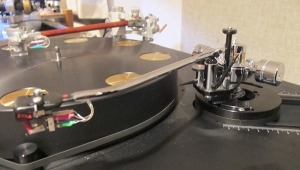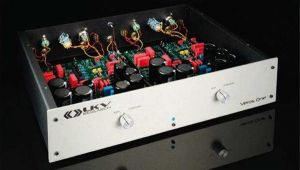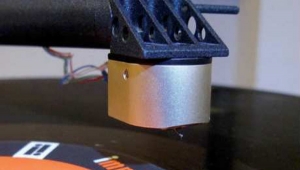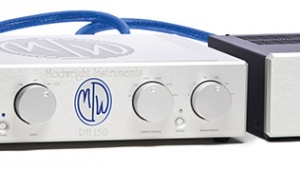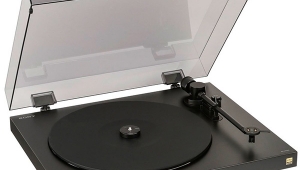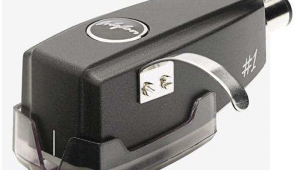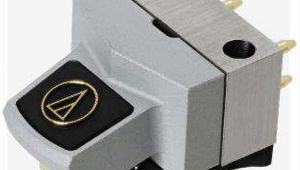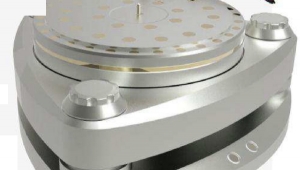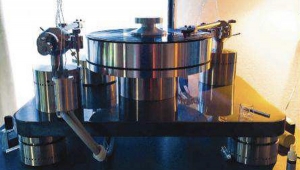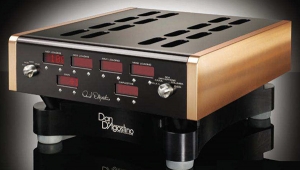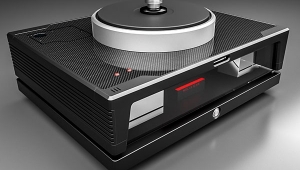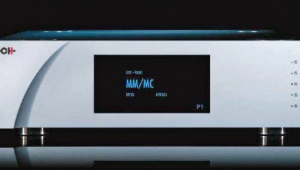| Columns Retired Columns & Blogs |
Analog Corner #264: Ortofon Windfeld Ti Cartridge
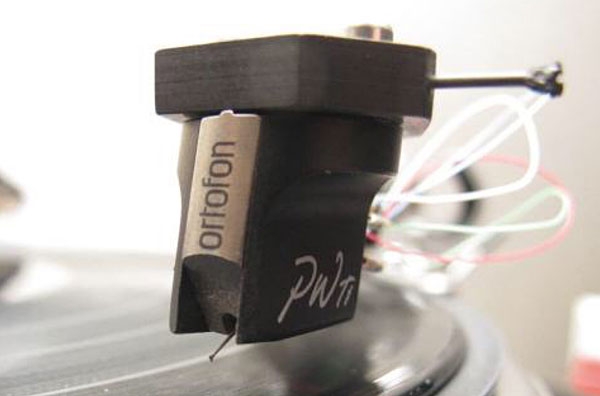
Ortofon (footnote 1), which turns 100 in 2018, launched the original Windfeld cartridge nearly a decade ago. Named for cartridge designer Per Windfeld—who had just retired at age 75, after 30 years with the company—that top-of-the-line cartridge cost $3400 at the time of its introduction.
Footnote 1: Ortofon A/S, Stavangervej 9, DK-4900 Nakskov, Denmark. US subsidiary: Ortofon Inc., 500 Executive Boulevard, Suite 102, Ossining, NY 10562. Tel: (914) 762-8646. Fax: (914) 762-8649. Web: www.ortofon.com.
Between 1976 and 2006, Per Windfeld oversaw the development of cartridges from the top to the bottom of Ortofon's extensive line, including the MC 20, MC Rohmann, and MC Jubilee, as well as Ortofon's many series of models: MC Super, Kontrapunkt, MC Rondo, and the budget-priced OM and Concorde DJ series. In a recent interview, Windfeld said that he figures he's developed at least 50 cartridge models. I'm glad he's still going strong, and has lived to see the remarkable resurgence of vinyl.
The original Windfeld cartridge was the first developed by its namesake's successor, Leif Johannsen, Ortofon's manager of R&D. It retained many of the Per Windfeld innovations found in other Ortofons, including Wide Range Damping (WRD): two dampers of different viscosities clamping between them a small, heavy, metal disc. At the time, Ortofon claimed that the WRD assembly produces ideal motor damping throughout and beyond the audioband, to help produce a linear, unusually extended frequency response and outstanding tracking at a vertical tracking force (VTF) of 2.6gm.
The original Windfeld's low-mass, high-rigidity generator had a boron cantilever and coils wound with Ortofon's Aucurum wire—gold-plated, 99.9999%-oxygen-free monocrystalline copper—onto a precision armature. The claimed results are high channel separation, lower distortion, and better channel balance. A strong neodymium magnet system combined elements of Per Windfeld's Kontrapunkt and MC Jubilee designs with a Field Stabilizing Element (FSE) inside the magnet system, to produce a linear magnetic field throughout the armature's movement. The result, according to Ortofon, was a 4 ohm, 0.3mV-output system with lower levels of intermodulation and dynamic distortion.
Though the original Windfeld's tall, thin, gracefully sculpted body superficially resembled the Kontrapunkt bodies, it was a new design that integrated the threaded headshell mount with the generator's central inner structure, thus providing a more secure, direct mechanical connection between the generating system and headshell. That Windfeld's black body was made of a "special alloy" whose specifics Johannsen was unwilling to reveal, other than that it was "highly damped and very hard." The low-mass, high-rigidity generator system featured a boron cantilever to which was attached an ultrafine-polished version of Ortofon's now-familiar Replicant stylus, which has extremely low mass and large vertical contact area. The Windfeld was a relatively heavy cartridge at 13gm.
I've devoted so many words to the original Windfeld because its replacement, the Windfeld Ti, introduced at the May 2017 High End Show in Munich, retains many of its design elements. However, in many other aspects the Ti differs significantly, beginning with its central inner structure, which is made of titanium (hence the Ti in the new model's name) using Selective Laser Melting (SLM), a technology Ortofon first used in 2008, in the manufacture of the revolutionary and still exceptional MC A90. The titanium inner structure flares at the top, creating a plate that's wide enough to be tapped for the holes for the cartridge-fastening bolts. Integral to that plate's surface are three carefully positioned contact ridges that precisely couple cartridge to headshell. The black outer body, which incorporates the output-pin block, is machined from stainless steel. At 11gm, the Windfeld Ti is 2gm lighter than the original Windfeld.
Over the past few years, Johannsen has been trickling down the magnet and armature technology he originally developed for the top-of-the-line MC Anna ($8924), first to the MC A95 and now to the Windfeld Ti. The Anna's magnet system is designed with carefully optimized geometry and materials that produce consistent flux density and a magnetic field of uniform strength, which Ortofon says result in identical flux density around and within each coil, regardless of its position. This, they claim, preserves dynamics and impulse linearity.
Of equal if not greater significance is that the Anna's optimized magnet system meant that its polymer-based armature could be nonmagnetic and lightweight. Because the armature is nonmagnetic, when it moves it doesn't alter the magnetic field, which means it can move more freely and without magnetic resistance. Yet the system's magnetic efficiency is high enough that the number of coil turns could remain low to keep the mass down while still generating an output of 0.2mV. All in all, an impressive engineering achievement.
The MC A95's armature isn't nonmagnetic, but it's made of an alloy less magnetic than the MC A90's armature, and with improvements in the magnet system, its fewer turns of wire still manage to produce 0.2mV output. If you want to hear the MC A95 in action driving the CH Precision P1/X1 phono preamplifier, listen to my AnalogPlanet Radio Show devoted to John Mellencamp. Even though the audio has been downrezzed on Soundcloud, the MC A95's sonic improvements over the MC A90—as well as the character of the P1/X1—are easy to hear.
Similarly, the Windfeld Ti's armature, while not totally nonmagnetic, is far less magnetic than the original Windfeld's. The Ti's 0.2mV output is 0.1mV lower than the original Windfeld's 0.3mV, and its internal impedance is 7 ohms—3 ohms more than the original's. A higher internal impedance usually results from more turns of wire being required to achieve the desired output.
In short, the magnet system in the Windfeld Ti ($4390) isn't as strong or as sophisticated as the one in the MC A95 ($6499). But the Windfeld Ti costs only $600 more than the original Windfeld of a decade ago, and for that you get an SLM titanium body and a more sophisticated generator with a less magnetic armature, the benefits of which should be audible.
Pair Windfeld
Because it outputs only 0.2mV, the Windfeld Ti needs to be paired with a very-low-noise phono preamplifier capable of sufficient gain, whether active or transformer-based. You could try a phono preamp based on current rather than voltage amplification, such as the CH Precision P1—but if you can afford to spend $30,000+ on a phono preamp, you're not going to stop at a $4000+ cartridge.
There's also MR Labs' Vera 10 phono preamp, which costs under $3000. Sadly, MR Labs' founder and original CEO, Max Rottman, passed away last year, but I've heard that the company will continue under new ownership, and I'll be reviewing the Vera 10 soon, in this column or on AnalogPlanet.com (footnote 2). I ran the Windfeld Ti using both the CH Precision and the Ypsilon VPS 100 Silver Edition phono preamps, the latter with Ypsilon's MC 16L step-up transformer.
With Ortofon's specially polished Nude Replicant 100 stylus and boron cantilever, setup is particularly critical. Because of its severe profile, which closely resembles that of a cutting stylus, the Replicant can extract maximum information from the groove—but unless every aspect of setup is performed precisely, especially vertical tracking angle (VTA) and stylus rake angle (SRA), it can sound hard and edgy. I've read more than a few reviews of Replicant-equipped Ortofons that said more about the writer's poor setup skills than about the cartridge itself.
Footnote 1: Ortofon A/S, Stavangervej 9, DK-4900 Nakskov, Denmark. US subsidiary: Ortofon Inc., 500 Executive Boulevard, Suite 102, Ossining, NY 10562. Tel: (914) 762-8646. Fax: (914) 762-8649. Web: www.ortofon.com.
Footnote 2: See my review of MR Labs' more costly Vera 20 phono preamp here.
- Log in or register to post comments

